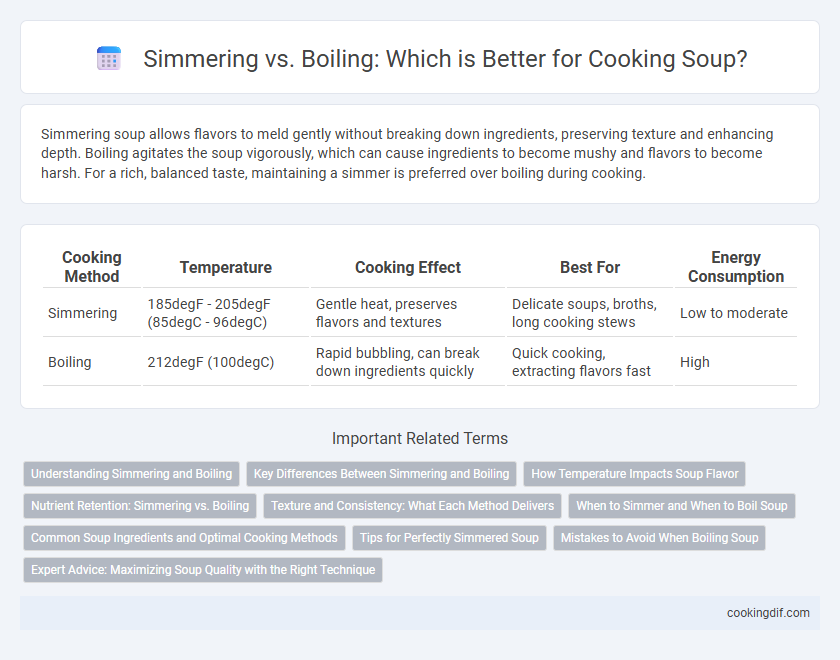Simmering soup allows flavors to meld gently without breaking down ingredients, preserving texture and enhancing depth. Boiling agitates the soup vigorously, which can cause ingredients to become mushy and flavors to become harsh. For a rich, balanced taste, maintaining a simmer is preferred over boiling during cooking.
Table of Comparison
| Cooking Method | Temperature | Cooking Effect | Best For | Energy Consumption |
|---|---|---|---|---|
| Simmering | 185degF - 205degF (85degC - 96degC) | Gentle heat, preserves flavors and textures | Delicate soups, broths, long cooking stews | Low to moderate |
| Boiling | 212degF (100degC) | Rapid bubbling, can break down ingredients quickly | Quick cooking, extracting flavors fast | High |
Understanding Simmering and Boiling
Simmering involves cooking soup at a temperature just below boiling, around 185 to 205degF (85 to 96degC), allowing flavors to meld gently without breaking down delicate ingredients. Boiling occurs at 212degF (100degC), creating vigorous bubbles that can cause ingredients to overcook and the soup to become cloudy. Understanding these temperature differences helps maintain texture and clarity while developing deeper, more balanced flavors.
Key Differences Between Simmering and Boiling
Simmering maintains soup at a gentle temperature of around 185-205degF (85-96degC), allowing flavors to meld and ingredients to cook evenly without breaking apart. Boiling occurs at 212degF (100degC), causing rapid bubbles that can toughen proteins and break down delicate vegetables. Simmering ensures a clearer broth and balanced texture, while boiling intensifies heat but risks overcooking and cloudy results.
How Temperature Impacts Soup Flavor
Simmering soup at a temperature between 185degF and 205degF preserves delicate flavors and allows ingredients to meld gradually, enhancing the overall taste complexity. Boiling, which occurs at 212degF, can cause volatile oils and aromatics to evaporate rapidly, resulting in a loss of nuanced flavors and a harsher taste. Temperature control during cooking is crucial for developing depth and balance in soup flavor profiles.
Nutrient Retention: Simmering vs. Boiling
Simmering soup at a consistent low temperature preserves delicate vitamins and minerals better than boiling, which can cause nutrient loss through evaporation and heat degradation. Boiling agitates the soup vigorously, breaking down nutrients like vitamin C and certain B vitamins more rapidly. Maintaining a gentle simmer ensures maximum nutrient retention while enhancing flavor extraction from ingredients.
Texture and Consistency: What Each Method Delivers
Simmering soup maintains a gentle heat that preserves the integrity of ingredients, resulting in a smoother texture and more consistent flavor development. Boiling, by contrast, agitates the soup vigorously, which can break down delicate vegetables and proteins, leading to a less uniform consistency and a potentially cloudy broth. Choosing simmering ensures tender, well-integrated components whereas boiling accelerates cooking but risks compromising texture and clarity.
When to Simmer and When to Boil Soup
Simmering soup is ideal for cooking delicate ingredients and developing deep, complex flavors without breaking them down, usually at temperatures just below boiling (185-205degF or 85-96degC). Boiling is best for rapidly cooking tough ingredients like bones or large vegetables, as it reaches 212degF (100degC) and promotes faster heat transfer. Use simmering for gentle cooking phases and boiling for initial steps that require intense heat to extract flavors or soften hard components quickly.
Common Soup Ingredients and Optimal Cooking Methods
Simmering is ideal for common soup ingredients like vegetables, beans, and meats, allowing flavors to meld gently without breaking down delicate textures. Boiling can cause overcooking and toughness, especially in leafy greens and tender proteins, making it less suitable for these elements. Maintaining a simmer at around 185-205degF ensures optimal extraction of flavors and preserves ingredient integrity for rich, balanced soups.
Tips for Perfectly Simmered Soup
Maintaining a gentle simmer at around 185-205degF ensures flavors meld beautifully without overcooking ingredients or causing cloudy broth. Stir frequently and adjust heat to keep small bubbles consistently rising to the surface, preventing rapid boiling that breaks down delicate vegetables and proteins. Using a heavy-bottomed pot promotes even heat distribution, reducing hot spots that can scorch the soup and preserving a smooth, balanced taste.
Mistakes to Avoid When Boiling Soup
Boiling soup vigorously can cause ingredients to break down, resulting in a cloudy broth and a compromised texture. Avoid overheating to prevent toughening delicate proteins like chicken or fish and scalding dairy components, which leads to separation. Maintaining a gentle simmer preserves flavor balance and clarity, ensuring a well-crafted, visually appealing soup.
Expert Advice: Maximizing Soup Quality with the Right Technique
Simmering soup at a gentle temperature between 180degF and 205degF preserves delicate flavors and tenderizes ingredients without overcooking. Boiling at 212degF agitates the broth, causing fats to emulsify and flavors to become harsh or cloudy, diminishing soup quality. Expert chefs recommend maintaining a steady simmer to achieve a clear, flavorful broth and optimal texture in soups.
Simmering vs Boiling for cooking soup Infographic

 cookingdif.com
cookingdif.com